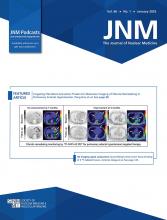Visual Abstract
Abstract
Prostate-specific membrane antigen (PSMA) PET was approved by the U.S. Food and Drug Administration in 2020 for the staging of newly diagnosed prostate cancer, yet rates of adoption and real-world positivity rates are unknown. We characterized patients undergoing PSMA PET staging and describe positive findings in a large national cohort. Methods: We identified all newly diagnosed prostate cancer patients in the national Veterans Health Administration from June 2020 to August 2023. Demographics, staging imaging reports, and cancer-related information were obtained from electronic medical record data. To assess positive findings, we chart-reviewed 1,994 patients (n = 657 low to intermediate risk) with staging PSMA PET reports available. Results: Among 31,838 patients with newly diagnosed prostate cancer, 4,538 (14%) underwent PSMA staging. Use of PSMA staging increased rapidly from near 0 in early 2021 to approximately 70% of patients with high- or very-high-risk disease by August 2023. Among patients who were N0/M0 by conventional imaging, PSMA PET positivity rates (N1 or M1) were 5.9% for favorable intermediate risk, 8.2% for unfavorable intermediate risk, 14% for high risk, and 34% for very high risk. Conclusion: PSMA PET staging for newly diagnosed prostate cancer increased rapidly in the Veterans Health Administration. Positivity rates were less than 10% in this large intermediate-risk cohort. These data confirm the utility of PSMA PET staging in high-risk disease and suggest that additional study is needed to refine patient selection in intermediate-risk disease.
- © 2025 by the Society of Nuclear Medicine and Molecular Imaging.
This article requires a subscription to view the full text. If you have a subscription you may use the login form below to view the article. Access to this article can also be purchased.
SNMMI members
Login to the site using your SNMMI member credentials
Individuals
Login as an individual user








